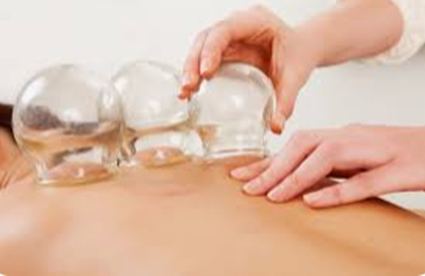Cupping Therapy: Everything You Need to Know
Cupping Therapy: Everything You Need to Know
In
recent years, alternative therapies have gained popularity as people seek
holistic approaches to health and wellness. One such therapy that has garnered
attention is cupping therapy. Cupping involves placing cups on the skin to
create suction, which proponents claim can promote healing and alleviate
various ailments. In this article, we will explore cupping therapy, its
history, potential benefits, and considerations to provide you with a
comprehensive understanding of this ancient practice.
What is Cupping Therapy?
Cupping
therapy is an ancient therapeutic technique that originated in traditional
Chinese medicine. It involves placing cups, typically made of glass, bamboo, or
silicone, on the skin. The cups create a vacuum or suction effect, either
through heat or mechanical means, which draws the skin and underlying tissues
into the cup. This suction is believed to stimulate blood flow, promote
lymphatic drainage, and release muscle tension.
Different Types of Cupping
There
are several types of cupping therapy commonly practiced:
Dry Cupping: In dry cupping, the cups are applied to the skin without any
additional substances. The suction effect is created by either heating the cups
or using mechanical devices.
Wet Cupping: Wet cupping involves making small incisions on the skin
after the cups are removed. This technique aims to draw out a small amount of
blood to remove toxins and promote healing.
Fire Cupping: Fire cupping is a traditional method where the cups are
briefly heated with a flame before being applied to the skin. The cooling air
inside the cup creates a vacuum effect, creating suction.
Potential Benefits of Cupping Therapy
Advocates
of cupping therapy suggest that it offers several potential benefits for
physical and mental well-being:
Pain Relief: Cupping therapy is often used to alleviate musculoskeletal
pain, such as back pain, neck pain, and muscle tension. The suction created by
the cups is believed to increase blood circulation, reduce inflammation, and
release tight muscles.
Improved Blood Circulation: Cupping therapy is thought to enhance blood flow to
the treated area, which can aid in the delivery of oxygen and nutrients to the
tissues. Improved circulation may promote healing and provide relief from
conditions like chronic headaches or migraines.
Relaxation and Stress Reduction: Many people find cupping therapy to
be deeply relaxing. The combination of the gentle suction and the localized
massage effect can help reduce stress, anxiety, and promote overall relaxation.
Detoxification: Cupping therapy is believed to help remove toxins from the
body by drawing them to the surface of the skin. This is particularly
associated with wet cupping, where the small incisions aim to eliminate impurities.
Considerations and Precautions
While
cupping therapy has been practiced for centuries and is generally considered
safe, there are a few considerations and precautions to keep in mind:
Bruising and Skin Discoloration: Cupping therapy often leaves
circular bruises or discoloration on the skin. These marks are temporary and
typically fade within a few days to a couple of weeks. However, individuals
should be aware of the potential for visible skin marks and consider this when
planning their treatment.
Skin Sensitivity and Irritation: Some individuals may experience skin
sensitivity or irritation at the cupping sites. It is essential to communicate
any discomfort with the practitioner to adjust the treatment accordingly.
Infection and Contamination: To minimize the risk of infection, it is crucial to
ensure that the cups and any associated equipment used during cupping therapy
are properly sterilized. Seeking treatment from a qualified and experienced
practitioner can help mitigate these concerns.
Not Suitable for Everyone: Cupping therapy may not be suitable for individuals
with certain medical conditions, such as skin ulcers, deep vein thrombosis, or
bleeding disorders. Pregnant women, as well as those who are menstruating,
should also exercise caution or avoid cupping therapy altogether.
Cupping
therapy is an ancient therapeutic technique that has gained popularity in
recent years. While the evidence supporting its effectiveness is limited, many
individuals find it to be a relaxing and potentially beneficial practice for
pain relief, improved blood circulation, and stress reduction. If you are
considering cupping therapy, it is essential to consult with a qualified
practitioner who can assess your individual needs and provide appropriate
guidance. Additionally, it is important to remember that cupping therapy should
not be considered a substitute for conventional medical treatment. As with any
alternative therapy, it is advisable to discuss cupping with your healthcare
provider before incorporating it into your wellness routine.






Comments
Post a Comment